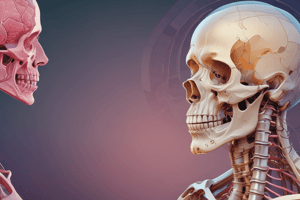Podcast
Questions and Answers
What does the acronym 'PET' stand for in PET scan?
What does the acronym 'PET' stand for in PET scan?
- Pulse Energy Technique
- Photoelectric Transducer
- Positron Emission Tomography (correct)
- Proton Electron Transfer
What is the primary use of a PET scan?
What is the primary use of a PET scan?
- Detecting cancer and evaluating its spread (correct)
- Diagnosing broken bones
- Measuring blood pressure
- Monitoring brain activity
Which of the following is a common tracer used in PET scans?
Which of the following is a common tracer used in PET scans?
- Fludeoxyglucose (FDG) (correct)
- Barium sulfate
- Iodine-131
- Technetium-99m
Does PET scan use radioactive tracers to create 3D images of the inside of the body?
Does PET scan use radioactive tracers to create 3D images of the inside of the body?
Is the file provided a PDF document?
Is the file provided a PDF document?
Is PET scan primarily used to diagnose conditions like cancer, heart disease, and brain disorders?
Is PET scan primarily used to diagnose conditions like cancer, heart disease, and brain disorders?
Describe the process of PET scanning and how it differs from other imaging techniques.
Describe the process of PET scanning and how it differs from other imaging techniques.
What are some advantages and limitations of PET scanning in medical diagnosis?
What are some advantages and limitations of PET scanning in medical diagnosis?
How does the use of PET scanning contribute to personalized medicine and treatment plans?
How does the use of PET scanning contribute to personalized medicine and treatment plans?
Match the following medical imaging techniques with their primary use:
Match the following medical imaging techniques with their primary use:
Match the following radioisotopes with their common use in PET scanning:
Match the following radioisotopes with their common use in PET scanning:
Match the following PET scan applications with their specific medical purposes:
Match the following PET scan applications with their specific medical purposes:
Flashcards are hidden until you start studying
Study Notes
PET Scan Basics
- PET stands for Positron Emission Tomography
- Primary use of a PET scan: to create 3D images of the inside of the body to diagnose conditions like cancer, heart disease, and brain disorders
PET Scan Process
- Uses radioactive tracers to create 3D images of the inside of the body
- Involves injecting a small amount of radioactive material into the body, which accumulates in areas with high metabolic activity
- A scanner detects the radiation and produces detailed images of the body's internal structures
PET Scan vs. Other Imaging Techniques
- Distinguishing feature: ability to measure metabolic activity and function, unlike other imaging techniques that only show structure
- Combines functional information with anatomical information
Advantages and Limitations
- Advantages: non-invasive, can detect diseases at an early stage, and provides detailed information about metabolic activity
- Limitations: expensive, not widely available, and may not be suitable for certain patients (e.g., pregnant women)
PET Scan Applications
- Cancer diagnosis and treatment: to identify cancerous tissues, monitor treatment response, and detect recurrences
- Heart disease diagnosis: to assess heart function and detect heart disease
- Brain disorders diagnosis: to study brain function and detect conditions like Alzheimer's disease
Contributions to Personalized Medicine
- Enables personalized treatment plans by providing detailed information about disease progression and treatment response
- Helps doctors tailor treatment strategies to individual patients' needs
Matching Exercises
- Match medical imaging techniques with their primary use:
- PET scan: diagnosing conditions like cancer, heart disease, and brain disorders
- Other imaging techniques (e.g., CT, MRI, X-ray): showing internal structures and anatomy
- Match radioisotopes with their common use in PET scanning:
- Fluorine-18 (F-18): cancer diagnosis
- Other radioisotopes (e.g., oxygen-15, nitrogen-13): heart disease and brain disorders diagnosis
- Match PET scan applications with their specific medical purposes:
- Cancer diagnosis and treatment: identifying cancerous tissues, monitoring treatment response, and detecting recurrences
- Heart disease diagnosis: assessing heart function and detecting heart disease
- Brain disorders diagnosis: studying brain function and detecting conditions like Alzheimer's disease
Studying That Suits You
Use AI to generate personalized quizzes and flashcards to suit your learning preferences.




